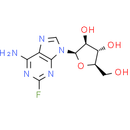Description
Fludarabine (NSC 118218) is a DNA synthesis inhibitor, which also inhibits phosphorylation of STAT1. Fludarabine, a pro-drug, is converted metabolically by dephosphorylation to the antimetabolite, F-ara-A.
Product information
CAS Number: 21679-14-1
Molecular Weight: 285.23
Formula: C10H12FN5O4
Synonym:
HSDB 6964
HSDB6964
HSDB-6964
NSC 118218
NSC118218
NSC-118218
Related CAS Number:
75607-67-9 (Fludarabine phosphate)
Chemical Name: (2R, 3S, 4S, 5R)-2-(6-amino-2-fluoro-9H-purin-9-yl)-5-(hydroxymethyl)oxolane-3, 4-diol
Smiles: NC1=NC(F)=NC2=C1N=CN2[C@@H]1O[C@H](CO)[C@@H](O)[C@@H]1O
InChiKey: HBUBKKRHXORPQB-FJFJXFQQSA-N
InChi: InChI=1S/C10H12FN5O4/c11-10-14-7(12)4-8(15-10)16(2-13-4)9-6(19)5(18)3(1-17)20-9/h2-3,5-6,9,17-19H,1H2,(H2,12,14,15)/t3-,5-,6+,9-/m1/s1
Technical Data
Appearance: Solid Power
Purity: ≥98% (or refer to the Certificate of Analysis)
Solubility: DMSO 57 mg/mL (199.84 mM)
Shipping Condition: Shipped under ambient temperature as non-hazardous chemical or refer to Certificate of Analysis
Storage Condition: Dry, dark and -20 oC for 1 year or refer to the Certificate of Analysis.
Shelf Life: ≥12 months if stored properly.
Stock Solution Storage: 0 - 4 oC for 1 month or refer to the Certificate of Analysis.
Drug Formulation: To be determined
HS Tariff Code: 382200
How to use
In Vitro:
Fludarabine efficiently inhibits the proliferation of RPMI 8226 cells with IC50 of 1.54 μg/mL. The IC50 of Fludarabine against MM.1S and MM.1R cells is 13.48 μg/mL and 33.79 μg/mL, respectively. In contrast, U266 cells are resistant to Fludarabine with IC50 of 222.2 μg/mL. Fludarabine treatment results in increased number of cells in the G1 phase of cell cycle, accompanied with a concomitant reduction of cells at the S phase of cell cycle in a time-dependent manner. Fludarabine induces a cell cycle block and triggers apoptosis in MM cells. Fludarabine triggers time-dependent cleavage of caspase-8, -9, and -3, -7, followed by PARP cleavage. Fludarabine increases expression of Bax in a time-dependent fashion, while the expression of Bak doesn't change. After exposure to Fludarabine for 12 hours, RPMI 8226 cells shows a loss of membrane potential with 61.05% of the cells expressing low fluorescence of rhodamine 123 compared with 8.62% of cells in untreated control. To enhance solubility, Fludarabine is formulated as the monophosphate (F-ara-AMP, fudarabine), which is instantaneously and quantitatively dephosphorylated to the parent nucleoside upon intravenous infusion. Inside the cells rephosphorylation occurs which leads to fuoroadenine arabinoside triphosphate (F-ara-ATP), the major cytotoxic metabolite of F-ara-A. Fludarabine can also induce pro-inflammatory stimulation of monocytic cells, as evaluated by increased expression of ICAM-1 and IL-8 release. Fludarabine does not affect the growth of ovarian cancer cell lines, whereas it induces marked and dose-dependent inhibition of proliferation in melanoma cell lines. Fludarabine induces significant reduction of STAT-1 phosphorylation, whereas it does not change JAK2 activation. Interestingly, Fludarabine does not significantly affect the phosphorylation of these three STAT proteins. Fludarabine (1.5 mg) significantly prevents STAT-1 phosphorylation and also reduces the increased amount of this protein. No significant changes are demonstrated in JAK2 phosphorylation at 2 days, but Fludarabine inhibits JAK2-increased expression at 7 days. Fludarabine specifically inhibits STAT-1 activation without affecting other STAT proteins and consequently diminishes VSMC proliferation.
In Vivo:
Tumors treated with PBS grow rapidly to approx-imately 10-fold their initial volume in 25 day, whereas, the tumors in the Fludarabine at 40 mg/kg increase less than 5-fold. A significant antitumor effect of 40 mg/kg Fludarabine on RPMI8226 tumor growth is demonstrated. RPMI8226 tumors treated with 40 mg/kg Fludarabine at day 10 increase apoptotic nuclei. Fludarabine is effective in suppressing RPMI8226 myeloma xenografts in SCID mice.
References:
- Fernández-Calotti P, et al. Int Immunopharmacol. 2006, 6(5), 715-72
- Brachwitz H, et al. Bioorg Med Chem. 1999, 7(6), 1195-1200.
- Meng H, et al. Eur J Haematol. 2007, 79(6), 486-493.
Products are for research use only. Not for human use.
Payment & Security
Your payment information is processed securely. We do not store credit card details nor have access to your credit card information.


